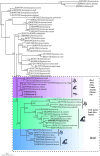Molecular detection and phylogenetic identification of Toxoplasma gondii-like strains, Hepatozoon ixoxo and Lankesterella sp. in frogs and toads
- PMID: 40230797
- PMCID: PMC11994708
- DOI: 10.3389/fvets.2025.1568298
Molecular detection and phylogenetic identification of Toxoplasma gondii-like strains, Hepatozoon ixoxo and Lankesterella sp. in frogs and toads
Abstract
Introduction: Despite Pakistan's rich amphibian fauna, frog and toad species remain largely unexplored regarding blood-borne parasites.
Methods: This study aims to investigate potential infections by toxoplasma gondii and Hepatozoon spp. in four amphibian species (n = 223) collected from various regions in Punjab and Khyber Pakhtunkhwa provinces.
Results: Molecular analyses revealed that 17 out of 223 amphibians (7.6%) were infected with Hepatozoon spp., with the highest infection rates found in Bufo olivaceous (20.0%), followed by Bufo stomaticus (9.3%) and Hoplobatrachus tigerinus (5.05%). DNA sequencing and BLAST analysis confirmed the presence of Hepatozoon ixoxo and Lankesterella sp. phylogenetic analysis of both pathogens demonstrated genetic diversity among the Pakistani isolates, clustering with isolates from birds, amphibians, and reptiles worldwide. To the best of our knowledge, this is first ever report globally where we are documenting that 4.5% of the screened Pakistani anurans, including frogs (H. tigerinus, 8.1%) and toads (B. stomaticus, 1.9%), were infected with toxoplasma gondii-like strains. Parasite prevalence varied between sampling sites and amphibian species. This study represents the first report from Pakistan documenting the prevalence and genetic characterization of Hepatozoon sp., Lankesterella sp., and T. Gondii-like strains among amphibians. We recommend conducting similar large-scale studies across various geo-climatic regions of Pakistan to further explore the epidemiology, genetic diversity, host-parasite interactions, and effective control of these pathogens among local frog and toad species. Identifying genetically related T. Gondii strains in unexpected host animals, such as amphibians, has been crucial for contributing to the elucidation of the parasite's evolutionary history.
Keywords: Bufo olivaceous; Bufo stomaticus; Hoplobatrachus tigerinus; Pakistan; amphibians; prevalence and phylogeny.
Copyright © 2025 Salim, Khan, Niazi, Aqdas, Dawoud, Usman, Muqaddas, Ullah, Belkahia, Khan, Ben Said and Iqbal.
Conflict of interest statement
The authors declare that the research was conducted in the absence of any commercial or financial relationships that could be construed as a potential conflict of interest.
Figures




Similar articles
-
Leading report on the molecular prevalence of emerging pathogens Hepatozoon sp. and Lankesterella sp. in the blood samples of seven wild lizard species.Sci Rep. 2025 Mar 15;15(1):9014. doi: 10.1038/s41598-025-91185-8. Sci Rep. 2025. PMID: 40089485 Free PMC article.
-
Molecular detection and phylogeny of Hepatozoon ophisauri and Toxoplasma gondii in wild lizards from Khyber Pakhtunkhwa, Pakistan.Folia Microbiol (Praha). 2025 Feb 22. doi: 10.1007/s12223-025-01250-y. Online ahead of print. Folia Microbiol (Praha). 2025. PMID: 39985744
-
First report of Hepatozoon and Lankesterella spp. infections in wild rodents from Pakistan, and their potential impact on blood parameters and oxidative stress markers in vital organs.Vet Res Commun. 2024 Nov 29;49(1):45. doi: 10.1007/s11259-024-10611-w. Vet Res Commun. 2024. PMID: 39612014
-
Genetic diversity of Toxoplasma gondii isolates from birds in the world: A systematic review.Exp Parasitol. 2023 May;248:108480. doi: 10.1016/j.exppara.2023.108480. Epub 2023 Feb 28. Exp Parasitol. 2023. PMID: 36863682
-
Epidemiology of Toxoplasmosis among the Pakistani Population: A Systematic Review and Meta-Analysis.Pathogens. 2022 Jun 10;11(6):675. doi: 10.3390/pathogens11060675. Pathogens. 2022. PMID: 35745528 Free PMC article. Review.
References
-
- Netherlands EC, Cook CA, Du Preez LH, Vanhove MPM, Brendonck L, Smit NJ. Monophyly of the species of Hepatozoon (Adeleorina: Hepatozoidae) parasitizing (African) anurans, with the description of three new species from hyperoliid frogs in South Africa. Parasitology. (2018) 145:1039–50. doi: 10.1017/S003118201700213X, PMID: - DOI - PMC - PubMed
-
- Sarwar MK, Malik MF, Hussain M, Azam I, Iqbal W, Ashiq U. Distribution and current status of amphibian fauna of Pakistan: a review. Electron J Biol. (2016) 12:243–6.
-
- Crittini AGF, Casiraghi M, Padoa-Schioppa E. New data on amphibian and reptiles of the northern area of Pakistan: distribution, genetic variability, and conservation issue. North West J Zool. (2010) 6:1–12.
LinkOut - more resources
Full Text Sources
Research Materials
Miscellaneous

